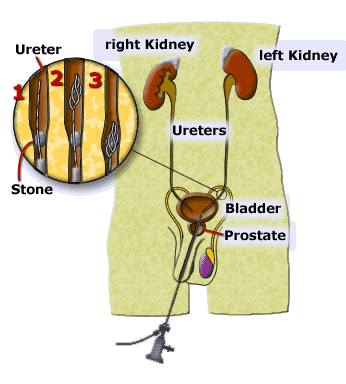 Overview
Overview
This procedure uses a small telescope (ureteroscope) that is passed from the outside through the urethra, the bladder, and then into the ureter to access the area that has either a stone, cancerous lesion, or requires a stent for urine and stone fragment drainage. In some cases a rigid scope is used. However, a flexible scope can be utilized at the surgeon’s discretion.
Indications
Ureteroscopy is beneficial as a diagnostic tool. This procedure can be utilized to locate a possible cause for the patient’s history of positive urinalysis findings and/or abnormal radiographs. Ureteroscopy is indicated for the treatment of a male or female patient with a confirmed stone that will not pass on its own, or a patient with a tumor or condition that requires a biopsy to be performed.
Analysis
If a stone is retrieved during the ureteroscopy procedure, and if ordered by the physician, the stone will be sent to the lab for chemical analysis. This will be helpful in determining follow-up treatment, and will help your physician advise you on how to prevent stones from coming back in the future.
If a biopsy specimen is recovered during the ureteroscopy procedure, we will send it to the lab for analysis by a pathologist. This is done to provide the physician with further information to effectively plan a course of treatment.
Types of Ureteroscopy Procedures
Ureteroscopy with stent placement
The stent placement is performed during the ureteroscopy. The placement of a ureteral stent is completed at the same time to alleviate any obstruction of the ureter because of stone, internal tumors, or external compression from other disease processes. Stents placed in the ureter serve several purposes. In the case of a kidney stone being broken up by a laser, it provides a protective lining for larger stone fragments to pass without damaging the ureter. Stents maintain dilation if the ureter swells from instrumentation during ureteroscopy. This will allow urine to pass unobstructed, consequently alleviating discomfort. Stents also serve as a support during the healing process.
Ureteroscopy with stone manipulation/extraction
When ureteroscopy is performed for the treatment of a stone in the ureter, the stone can be manipulated into position with instruments for extraction and a stone basket. The surgeon inserts a small basket through the ureteroscope, grasps the stone, and removes it.
Ureteroscopy with laser lithotripsy
On occasion, the stone may be too large to remove with a stone basket and must be crushed into smaller pieces for removal. The stone is struck with a laser beam, which breaks it into smaller pieces. We use the Holmium® Laser for this purpose. Stone fragments can then be removed with the stone basket or will flow out naturally with urine.
Ureteroscopy with removal of a tumor or biopsy
If ureteroscopy is performed for tumors, the ureteroscope is used as a conduit for laser and biopsy forceps to remove the tumor.
Although rare, a biopsy can be performed during a ureteroscopy. Some conditions call for a brush biopsy to be performed to gather tissue from inside the ureter for microscopic evaluation.
Pre-Operative Instructions
You will need to come into our office for a physician and to meet with our Pre-Admission Testing Registered Nurse (RN) who will obtain your medical history, provide complete instructions for your procedure, and answer any questions.
Diet and Medications
- Do not eat or drink anything after midnight prior to surgery
- Please notify the Surgery Department if you are taking any blood thinning medications in advance as soon as you are scheduled for your procedure.
- A Registered Nurse (RN) will instruct you regarding what medications to take prior to surgery. If the RN instructs you to take any medication(s) the morning of your procedure, please take them with only a sip of water.
Special Instructions
- Wear loose fitting clothing.
- Leave all valuables at home such as jewelry, watches, and large amounts of cash.
- Due to the small waiting area, please limit family members to 2 per patient.
- You must have a friend or family member drive you home after your surgery. If this arrangement is not made, your procedure may be cancelled. It is advised that an adult stay with you the first post-operative night.
Post-Surgical Instructions/Expectations
Diet
After surgery, try to drink more liquid than normal, approximately 3 quarts per day minimum for at least 5 days.
Activity
Do not drive, drink alcoholic beverages, transact legal business, care for a dependent person, or take public transportation alone for 24 hours after your procedure. Rest for the first 24 hours, then increase activity as tolerated.
Follow Up Appointment
Your recovery room nurse will arrange your follow-up appointment. It is important for your care that you keep that appointment. Please reschedule within a few days of the original appointment if you have a date or time conflict.
What to Expect
- You may have burning during urination for the rest of the day. You may sit in a tub of warm water for relief of burning.
- A small amount of blood in the urine is normal for several days after the ureteroscopy.
Tylenol may be taken for lower abdominal discomfort or bladder spasm. Follow manufacturer’s instructions for Tylenol. If symptoms are not relieved with a warm bath or Tylenol, or if you experience any problems, call your physician for assistance at (559) 321-2800.

 Overview
Overview